Introduction
On-site and Vendor-on-premise (VOP) programs provide a broad range of benefits for large users of staffing services.
With professional implementation and operations, the Onsite program allows customers to consolidate temp agency vendors, improve technology and employee benefits, and provide enhanced reporting and process improvement. This helps reduce the HR burden and vendor management requirements, and streamlines payroll, billing and workforce management.
This guide provides an overview of what onsite and VOP programs are, their benefits, and a summary of implementation and operations expectations. If you are interested in evaluating if an onsite program is right for you, contact information is provided at the end of this guide.
Contents
Finding a committed staffing partner who shares your values and can meet your expectations can be challenging—but is a critical piece of the puzzle.
In this paper, you’ll learn about the following:
- What is an Onsite or VOP Staffing Program?
- Benefits of an Onsite Staffing Program
- Should Your Staffing Partner be Strategic or Tactical?
- Is Your Staffing Partner Providing Value?
- Offshore/Offsite or Onsite Staffing Model — Which is Better for Your Company?
- Using an Onsite Staffing Program to Increase Productivity
First, let’s begin by explaining what an onsite or VOP staffing program is.
What is an Onsite or VOP Staffing Program?
Staffing firms typically provide their services through independent, stand-alone branch offices. For large users, an onsite staffing program is a great solution.
Other than back-office, shared services provided by a corporate headquarters and branch offices provide all the service delivery to their customers—recruiting, account management, payroll, and business development. When a client is large enough, the temp agency will locate (co-locate) a branch office on or at the site of the customer; thus, an “onsite” program.
An On-site (or Vendor On Premise, VOP) is a great way to get superior, well-managed staffing services for large or larger users of temporary staffing services. The ability to manage service delivery onsite allows for improved services and benefits for the customer, the staffing firm, and for the employees—allowing the agency to recruit, process, and manage its workforce “on location” and providing significant benefits to the customer and the staffing firm.
As mentioned, for most small to mid-sized customers, their temporary needs are serviced and supplied by a local branch office of the temp agency. As customers are or become larger service delivery becomes more complex and may overwhelm a local branch office.
To understand what an onsite program is, it’s important to understand the need.
Why the Need for an Onsite Program?
Many companies with large facilities—manufacturing, warehousing, distribution, and logistics, for example—may have thousands of employees but need even more for peak or seasonal demands.
An onsite staffing model provides a robust, unified, and holistic workforce strategy—with a personal and expert touch. There’s a team of staffing professionals onsite who manage talent acquisition, employee engagement & retention while measuring the effectiveness and efficiencies of the program—pivoting as the workforce dynamics change. This team acts as an extension of your HR department to streamline your staffing function.
Having an onsite strategy offers scalability, flexibility, hands-on engagement/management, and risk mitigation.
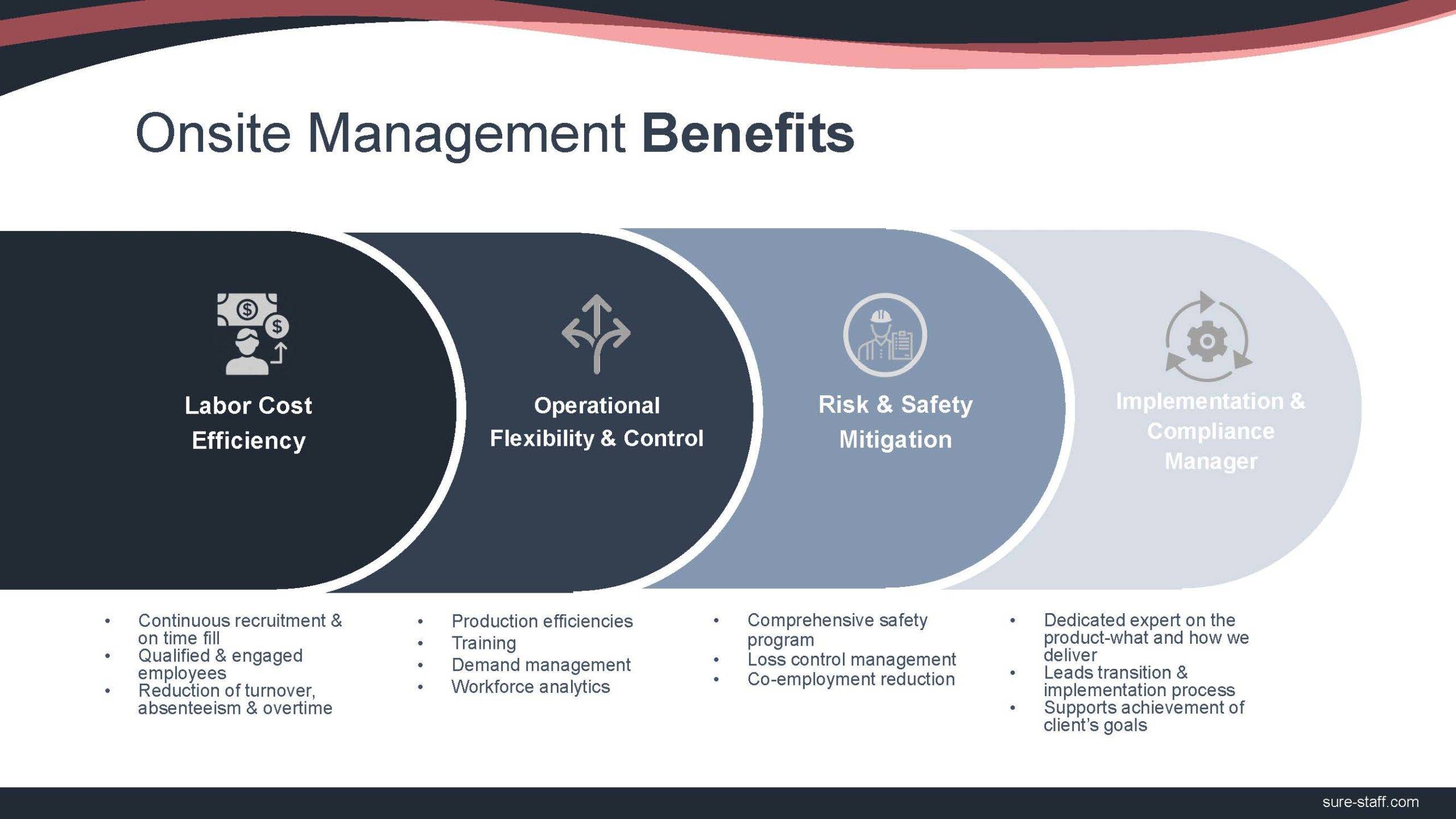
Benefits of an Onsite or VOP Staffing Program
There are many benefits of having a vendor-on-premise relationship. Most importantly, your internal HR department is allowed to focus on more strategic issues, and on the needs of your full-time employees. Additionally, a VOP relationship can make staffing both easier and more cost-efficient by:
- Lowering labor and HR costs: Provides a team to focus on talent acquisition, engagement & retention with precision focus having the ability & resources to pivot as the workforce needs change and/or fluctuate.
- Reducing downtime: Handles the scheduling for the temporary workforce to ensure all areas are adequately staffed by proactively building in contingency plans.
- Scaling the workforce: Evaluates staffing needs to plan for peak and non-peak times, as well as handles all temporary worker reassignments.
- Reducing time to fill: Recruits new temporary employees continuously on-site to ensure there’s always a large pool of candidates ready to work.
- Improving worker productivity: Deploys qualified temporary workers and ensures their productivity by training that includes hands-on learning & development.
- Improving process efficiency: Provides detailed staffing analytics reports including quarterly/annual business reviews. Results are utilized to determine the program’s success and/or any required modifications.
- Ensuring safety: Partners with you to ensure safety is never compromised. Adheres to all OSHA requirements including the temporary worker initiative. Continuously provides safety education by providing top-of-mind safety tips and talks.
- Measurement: A key to workforce management is measuring results and outcomes. An onsite program provides metrics and management dashboard tools for evaluating success.
More Detail
The benefits of an onsite program don’t stop with the customer. Many benefits are derived from the employees and workforce such as:
- Improved communications: On-the-fly changes to policies, procedures, workflow, benefits, shift changes, or work times/days, can be made in real-time and in-person—reducing communications lag, inefficiencies, or miscommunications.
- Added benefits or services to employees: Added perks or benefits are much more easily managed and provided onsite versus remotely through a branch. Incentives, promotions, celebrations, referral programs, and bonuses all improve morale and culture and can be easily implemented through onsite programs.
- Employee opportunities: Most temps want opportunities to gain new skills and higher wages and more diversity of job opportunities. Onsite programs allow for new opportunities to be readily available and explored.
The benefits of an onsite staffing program are broad—ranging from mechanical, reporting, timekeeping, metrics, and KPIs—to operational and cultural, efficient workforce management, function and vendor consolidation, and communications.
For large users of temporary staffing, an onsite program is when the temp agency co-locates an office or branch within the customer worksite. This allows for enhanced management of a large temp workforce and provides significant advantages and benefits to both the customer, agency, and temporary employees—it is a strategic decision.
What You Can Expect
Yields a better workforce strategy
Employing an onsite staffing model provides a robust, unified, and holistic workforce strategy with a personal and expert touch. Why? When you have a team of staffing professionals onsite, they are able to manage the critical HR tasks such as:
- Talent acquisition
- Employee engagement and recognition
- Job responsibilities and workflow
- Real-time staffing level management
- Payroll and Billing
- Retention
The onsite team acts as an extension of the customer’s HR department and can help streamline the overall recruiting staffing function.
A dedicated team immersed in your work environment helps ensure real-time staffing levels are optimized and provides the agency a better understanding of workflow, the manufacturing or distribution process, job responsibilities, and requirements. They handle all your contingent workforce scheduling needs and ensure that every area is staffed with the right personnel at the right time.
Lowers labor and HR costs
Having a dedicated team on-site allows for labor and HR cost savings.
Recruiting, hiring, training, and management of contingent employees are strategic and tactical and often consume a large amount of time and resources.
An onsite program allows the consolidation of vendors and the ability to outsource many critical HR functions—reducing the pressure and effort required by many large customers. Having a single point of contact for managing the temp workforce significantly reduces communications requirements and helps reduce errors and improves implementation and control of policies, training, and technology.
Streamlines and expands performance monitoring
KPIs and performance metrics become more important as large companies scale, or their reporting requirements become more complex.
Onsite programs typically offer pre-packaged reporting solutions and can provide tailored or customized reporting for customers on a case-by-case basis. This allows for tracking capability of the entire contingent workforce offering reporting that measures turnover, attendance, time to hire, overtime management, retention ratios, and the effectiveness of incentive programs on overall workforce management.
Improve job site safety
Onsite programs are a complete solution—including risk management and safety.
Safety should always be a top priority and having an onsite can help provide customized onboarding for temporary workers—ensuring they complete all safety training requirements in general or those specific to a particular customer.
Onsite programs also complement their offerings with added-value services such as safety briefings, assistance with OSHA evaluations, EEOC and NLRB briefings, workflow and equipment review, certifications, protocols, and training.
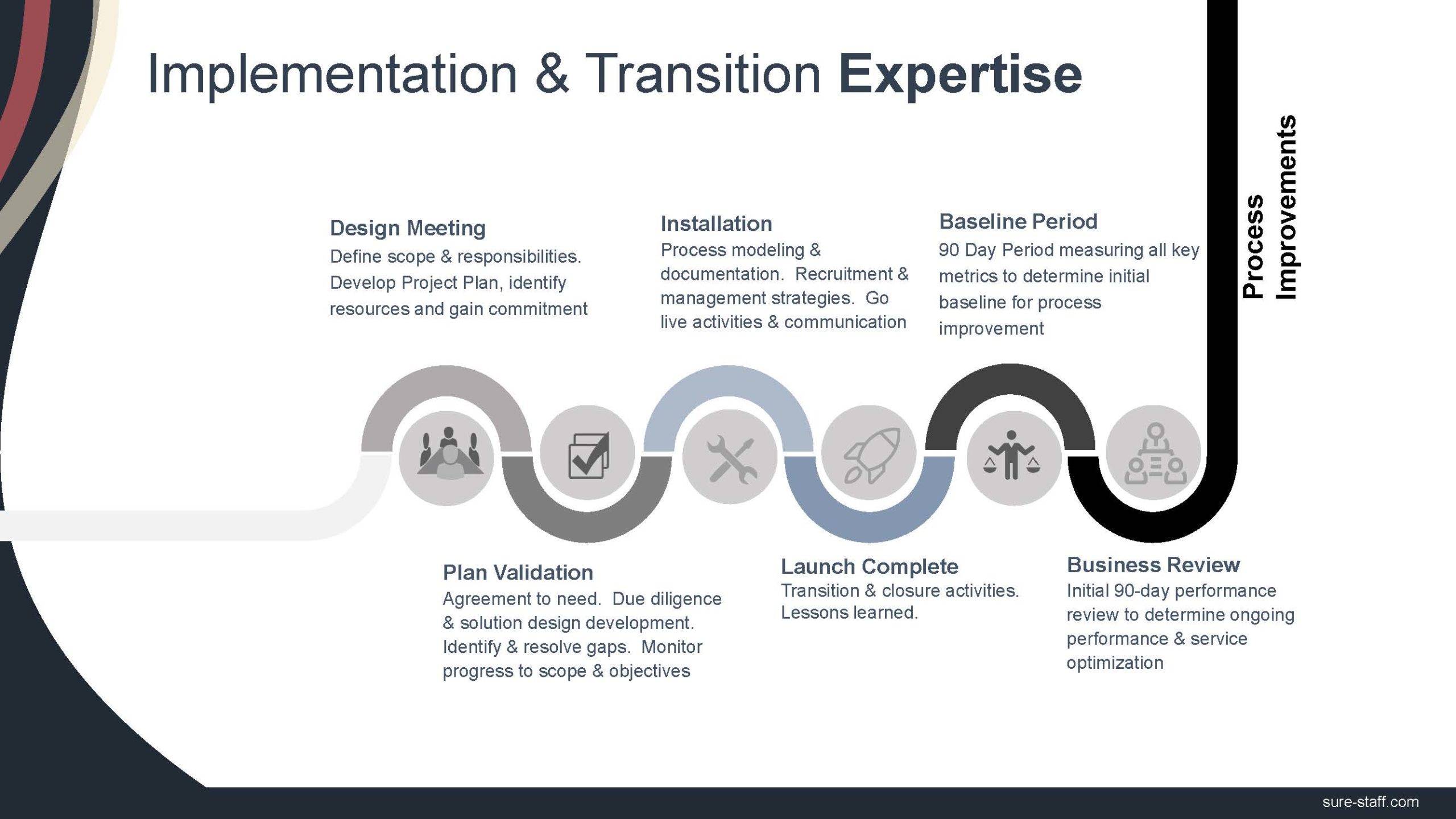
How Onsite Programs Work: Implementation to Operations
The development of an effective onsite program begins with careful design or proposed organization. This includes defining the scope and responsibilities of both the customer and staffing agency. A project plan is developed with timelines, resources are identified, and commitment and support is garnished for all stakeholders.
Next, plan validation is presented and reviewed. This is a key component of the process whereby the onsite staffing partner does final due diligence of processes and procedures are identified, gaps in operational or resources are identified and resolved, and project management tools are developed to monitor progress to scope and objectives.
Installation of the program follows. Again, this is a key element where appropriate staff – including the senior onsite manager – are hired, trained and provided a full, immersive orientation to the customer’s business. “Go live” and logistics are completed which may include communications, timekeeping, KPIs and reporting requirements, furniture, and process flow.
Launch is the next phase where actual implementation has begun. Gap analysis is used to identify improvements to process, technology and reporting. Baseline periods – typically 90 days from launch – are used to assess operational status and provide management reviews as to progress and any requirements for improved process, technology, and recruiting.
Scale your workforce
Is your company growing? Adding large customers? Introducing new services or production lines?
One great advantage of onsite staffing programs is the ability to outsource much of the staffing requirements to effectively scale. You have a partner that can do much of the “heavy lifting” needed to advertise, recruit, interview, screen, test, and onboard new employees as you grow.
The onsite partner can evaluate staffing needs and help plan for peak, seasonal, non-peak, and high-growth periods—significantly reducing the workload on HR departments and management.
Onsite staffing programs: An advanced solution for workforce management
Onsite programs offer many benefits and advantages to customers and employees. They help streamline the recruiting effort, provide improved reporting and risk/safety management, and allow a closer partnership with client companies allowing for efficiencies, increased productivity, reduced workflow, and improved culture.
As you can see, there are many benefits to having a staffing partner onsite—from lowering labor and HR costs to scaling your workforce, and more. In this next section, we’ll discuss the difference between strategic and tactical service delivery, as well as provide tips to help you create the right staffing plan for your organization.
Should Your Staffing Partner be Strategic or Tactical?
At Surestaff we are fortunate to work with many large customers throughout the country—primarily those that are large users of industrial staffing.
As a result, we periodically have the discussion of whether to provide strategic or tactical staffing services. Sometimes this decision is dictated by the customer, sometimes by the environment or size of the account.
With that said, what is the difference between tactical and strategic service delivery?
Tactical vs. strategic
Simply put, we view tactical service as “filling orders.” The customer tells us how many people they need and what skills, and we supply the people at the right time. The customer manages all aspects of the staffing vendor environment.
A strategic solution is more defined as “we” are the customer’s partner. We understand their business, help determine staffing loads, provide onsite and vendor management, provide KPIs, metrics and reporting, orientation and onboarding, and help identify and resolve inefficiencies or poor processes.
If circumstances allow, we recommend your staffing partner be “strategic” because a solid staffing plan requires that you first identify the gaps between your needs and your existing resources—setting the groundwork to determine staffing levels. So, don’t put the cart before the horse, so to speak. Once you’ve put a strategic plan in place, then and only then, should you act on the tactical steps to reach your goals.
Why you should employ a strategic staffing partner
Strategic staffing is designed to ensure that an organization has the workforce needed to meet its business objectives. This requires understanding trends, seasonality, product and supply chain flow, employee responsibilities and duties, and corresponding workforce requirements.
What are the benefits of working with a strategic staffing partner?
- Efficiencies gained by vendor consolidation and management
- Improved reporting, tracking, and metrics
- Improved safety, safety education, and risk management
- Elevated morale and day-to-day management of temporary employees
- It’s easier to address HR concerns when the company structure is more organized.
- You can better maximize staff utilization by ensuring that you don’t under or over-hire.
- HR teams can proactively hire and train new employees to meet future business needs.
How to create a strategic staffing plan
Not sure where to begin? The following five steps can help you and your staffing partner create a plan that is in line with your business goals:
Determine your goals.
Consider what the organization’s plan for growth is—do you need additional employees to staff a new location, for example? Do you plan to offer any new services? Do you have new sales goals? These are the types of items you’ll want to consider when creating your staffing plan. Consider the depth of your management “bench” and realistically assess their capacity for work and projects.
Identify personnel availability.
Are there any factors that could potentially impact the availability of personnel? Many large organizations first review data from the U.S. Bureau of Labor Statistics—which provides useful statistics on the numbers of job openings, labor costs, and unemployment rates.
Determine your functional needs.
Do you have the talent you need to promote from within, or do you need to recruit/hire externally? Sometimes, certain jobs can easily be filled through outsourcing to consultants or freelancers. When you are creating a strategy, it is first helpful to learn what skill sets and experience are needed in your current business divisions. Identify the capacity of your departments. Do they have the capability to manage multiple vendors, payroll, reporting, meetings, and day-to-day operations?
Conduct a gap analysis.
This is essentially when you compare the roles you currently have filled against the ones that you need to fill. In some cases, incorporating training and development could help fill the skills gap. When it comes to busier times for the business during peak seasons, you may want to consider hiring temporary workers to fill those gaps.
Create a plan.
Once you’ve identified all of the above, the final step is to combine that information in order to create an actionable plan. Your strategic staffing plan should ultimately include your assessment/analysis of the business, as well as take the individual business units and departments’ needs into consideration.
Keys to a successful strategic staffing partnership
Just like with any other important business decision, choosing your staffing provider should be done with care and diligence. It’s crucial you develop a relationship with a staffing partner who understands your industry, your organizational goals, and longer-term business objectives.
When seeking a staffing partner, look for a match between the vision of your company and the staffing agency’s expertise.
Some key things to look for include flexibility, patience, adaptability, specialization, and industry reputation. Also consider their experience, use of technology, and especially their recruiting ecosystem.
We’ve discussed why your staffing partner should be strategic. But many successful HR leaders use both strategic and tactical strategies—choosing to manage the staffing environment internally.
For many companies, this is an excellent solution and works well. It’s important to both envision and plan your strategy, but you also need to be able to break it down into practical, workable, (and tactical) solutions that will ultimately bring the plan to life.
We’ve now shared the reasons why we think your staffing partner should be a strategic one, and also highlighted the importance of creating tactical solutions—to bring your plan to fruition. In this next section, we’ll discuss how to ensure that your staffing partner is truly providing value.
Is Your Staffing Partner Providing Value?
As you now know, hiring a staffing partner, or intermediary between workers and companies seeking employees can be a prime investment. That’s because a staffing partner ultimately helps organizations find professionals that match their hiring needs. Does your staffing partner provide real value?
By aligning with a strategic staffing partner who is invested in your company’s success, you’ll be better equipped to achieve your overall objectives.
The first step is locating and securing a staffing partner that is the right fit for your organization and culture.
How to choose the “right” staffing partner
Choosing the right provider is an important task that should not be taken lightly. When you partner with a staffing agency, keep in mind that they are an extension of your brand. You’ll want to ensure that the agency represents you in the right way because perception is everything. Furthermore, the candidate’s experience can greatly affect future job success and retention—hence why first impressions are so important.
The following are three key steps to take when selecting a staffing partner:
Partner with someone you can trust – You want to work with a recruiter you can trust who will find you the best candidates for the organization. It’s all about building a long-term relationship, as well as ensuring a team fit for the company.
Assess their use of Technology – In the past 10 years (and certainly in the past two years), technology has become a primary driver of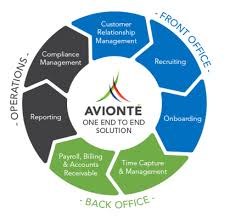 effectiveness and efficiencies for staffing companies. Applicant Tracking Systems such as Avionte’, have greatly advanced with the ability to leverage mobile technology. They now provide integrations to online job platforms, company job boards, employee and candidate engagement tools, communications, order processing, and self-placement capabilities. As with mobile apps for your Apple or Android device, there are flood of new applications for recruiting and retention. These tools are now critical to the success of your staffing partner.
effectiveness and efficiencies for staffing companies. Applicant Tracking Systems such as Avionte’, have greatly advanced with the ability to leverage mobile technology. They now provide integrations to online job platforms, company job boards, employee and candidate engagement tools, communications, order processing, and self-placement capabilities. As with mobile apps for your Apple or Android device, there are flood of new applications for recruiting and retention. These tools are now critical to the success of your staffing partner.
Make sure the firm understands the company’s goals – A right-fit partner is one that takes your company’s goals into consideration and has an in-depth understanding of your organization’s culture.
Pro tip: Start by reviewing 30, 60, and 90-day goals to make sure that you are properly aligned.
Select the right size agency – Are you seeking a small, boutique agency that focuses on niche roles, or do you desire a larger or more diverse supplier? Agencies that are more versatile can generally fill roles in multiple departments—lending themselves to be a better match.
Maximizing the value of your staffing partner
So, you’ve located and secured a staffing agency that you feel confident in—but how do you know if they are providing real value to your organization? You may only call on the staffing firm when you have an open role to fill, but you’ll want to ensure that you are truly maximizing their potential.
The following are ways to make sure that you’re getting the full value of this relationship:
Understanding the services you offer
Are you seeking temp employees, part-time, full-time, or all of the above? The range of services can vary from firm to firm and by the size of the agency. Staffing firms can perform retained searches, contract recruiting, and handle hiring and onboarding for specific functions. This is known as recruitment process outsourcing (RPO). Additionally, firms may also offer outplacement and payroll services. Knowing the menu of services offered and selecting the right items off the menu from the start, will allow you to get more value.
Finding the best fit employees
It goes without saying that the more information you provide to your staffing partner, the higher the likelihood they will provide an employee(s) who fits your needs. When seeking a temp or employee, try to be as specific as possible. For example, if filling an administrative role, spell out the exact type of work and duties that the employee will be doing i.e., answering phones, conducting research, etc. Also, be sure to consider the skill sets and overall culture in your office.
Agreeing on price
To avoid any surprises, you want to make sure that you agree on the best price possible (ahead of time) without sacrificing quality.
Consider on-site management
If you have a large volume of recurring staffing needs and need help with hiring, onboarding, and more, then you may want to consider having one or more members of the staffing agency sit on-site. This situation can be a win-win for all parties involved because face-to-face interactions make for a better employee-candidate experience.
Temp-to-perm and Direct Hire
Temp-to-hire or Direct Hire are several of the best ways to get value from a staffing firm. This approach can reduce the guesswork and risk while raising the odds of finding a candidate who fits well within your organization. It’s also a great opportunity for both you and the candidate to “try before you buy” and do a test run before committing to a job permanently.
Just be sure that you know what to expect from the agency and be prepared with what you bring to the table—in order to make the most of the collaborative partnership. When you are upfront and share your needs, a great staffing agency is one that will step up to the plate to represent your company.
As you can see, partnering with the right staffing agency can open the doors to building a great relationship, and ultimately be a game-changer for your organization. In this next section, we’ll discuss the differences between offshore/offsite, onsite, and hybrid models—to help you determine which staffing strategy is the right fit for your company.
Offshore/Offsite or Onsite Staffing Model — Which is Better for Your Company?
When it comes to staffing, finding the right person for the right position isn’t always easy. And it is one of the most important arrangements contributing to the overall development of your organization. People are our most important asset, and we’re only as good as our people.
Therefore, it’s important to choose the right staffing model for your company. The model you choose and the staffing company you work with may have an impact on the quality of people you hire and the effectiveness of your hiring process. But which is better—offsite/offshore or onsite?
Let’s start by discussing some of the pros and cons of both offsite and onsite staffing—to help you determine the strategy that will work best for you.
Offshore/offsite staffing
An offsite staffing model is often referred to as an “offshore”, “near-shore”, or “outsourced” solution whereby teams of recruiters source candidates and manage the recruiting workflow.
Why is it referred to as an “offsite model”? Because the recruiter teams are usually located in another country—typically the Philippines or India; therefore, offshore from the continental U.S. It has also become common to refer to these offshore groups synonymously as “RPOs” (Recruitment Process Outsourcing).
What are some of the benefits or drawbacks of this model?
| Advantages | Disadvantages |
| ● Offshore staffing is inexpensive and indeed, cheap. The cost of labor is dramatically lower than in the United States—often as much as 75% less.
● Being able to offshore and outsource specific, well-defined pieces of the recruiting process adds efficiencies and avoids developing and managing those processes in-house.
● Offsite staffing teams may be able to source hard-to-fill or niche roles due more easily to their access to a broader audience (read database—they typically have very large databases).
● Offshore outsourcing has become a highly popular recruitment option, and studies have shown that offsite staffing can help businesses save on operational costs. Outsourcing allows companies to avoid building the capacity, capability, and infrastructure internally
● When your staff is augmented offsite and offshore, you can shift your focus from hiring to employee engagement and more productive business activities.
| ● Language barriers. Most offshore recruiting firms (RPOs) reside in the Philippines or India. That can make it difficult to communicate effectively. We have all experienced offshore-based customer service (usually your favorite credit card company). It can be very frustrating.
● Developing relationships, team bonding, and motivation are more difficult to achieve when you have teams working offshore. Collaboration and project management are difficult.
● It can be challenging to implement new business processes and systems when working with staff offshore. The benefits of ad hoc meetings, testing, reviewing, and development—even in the days of Zoom calls—slowly grind the process of productivity.
● Accountability is effectively non-existent. Horror stories abound of clients being left holding the bag after an RPO vendor walks away in the middle of a project—with the money.
● The relationship that RPOs have with candidates is often superficial, and in some cases, just a candidate’s name and number. The bond developed with an onsite recruiter is lost or does not exist. |
Onsite staffing
A pure “onsite” model is where the staffing partner co-locates a branch office at your company’s location. An onsite staffing model can help your company achieve a more unified strategy due to the personal touch of the team being local. This scenario also allows for a customized solution that better serves your business goals.
Just like with offsite staffing, there are pros and cons.
| Advantages | Disadvantages |
| ● A dedicated recruiting team works onsite at your location with your HR and operations teams—which makes the team easily accessible.
● The onsite team is more likely to blend and adapt well to your work environment, corporate culture, and policies. Communication, productivity, and delivered services are greatly enhanced.
● Onsite programs are often enhanced by national or corporate-based recruiting centers. These centers act like RPOs and provide national recruiting coverage by a team of US-based account managers. They too have sophisticated recruiting tools supported by a robust database of candidates.
● The availability of onsite staffing agents can greatly help during peak seasons when temporary or contract workers are needed.
● An onsite team provides hands-on management, accurate recruitment, and oftentimes mitigates risk. They can provide training, onboarding, risk assessment and mitigation, safety, and injury management, and can learn details of your operation, processes, policies, and guidelines. | ● The most recognizable disadvantage is the cost. Onsite programs can be expensive. This is understandable.
● The operating expenses of a co-located branch office must be “baked into” the fees to the customer. As a result, onsite programs are most typically reserved for large volumes…the breakeven being 50-75 employees.
● A pure onsite model can be limited due to working within one time zone and the “regular” workday ending. However, most onsite programs are supplemented by corporate-based recruiting centers that offer time-zone flexibility.
|
Hybrid model
A hybrid program combines the best of the onsite and offsite staffing models.
In a “hybrid” scenario, the onsite branch (which could also be a traditional temp agency office) provides direct support to the customer and supplements that support using the RPO and/or a corporate-based recruiting center. In this hybrid model, the customer is not burdened with using or managing the RPO, and the RPO becomes an additional recruiting source for the onsite staffing office.
For customers large enough to justify the cost of an onsite, the hybrid works very well. You get all the advantages and benefits of each program with none of the disadvantages.
Hopefully, this information has helped you identify whether your organization will work best with an offshore/offsite, onsite, or hybrid staffing model. At SURESTAFF, we believe that employing an onsite staffing solution can greatly increase productivity on the job. In this final section, we’ll share three ways how.
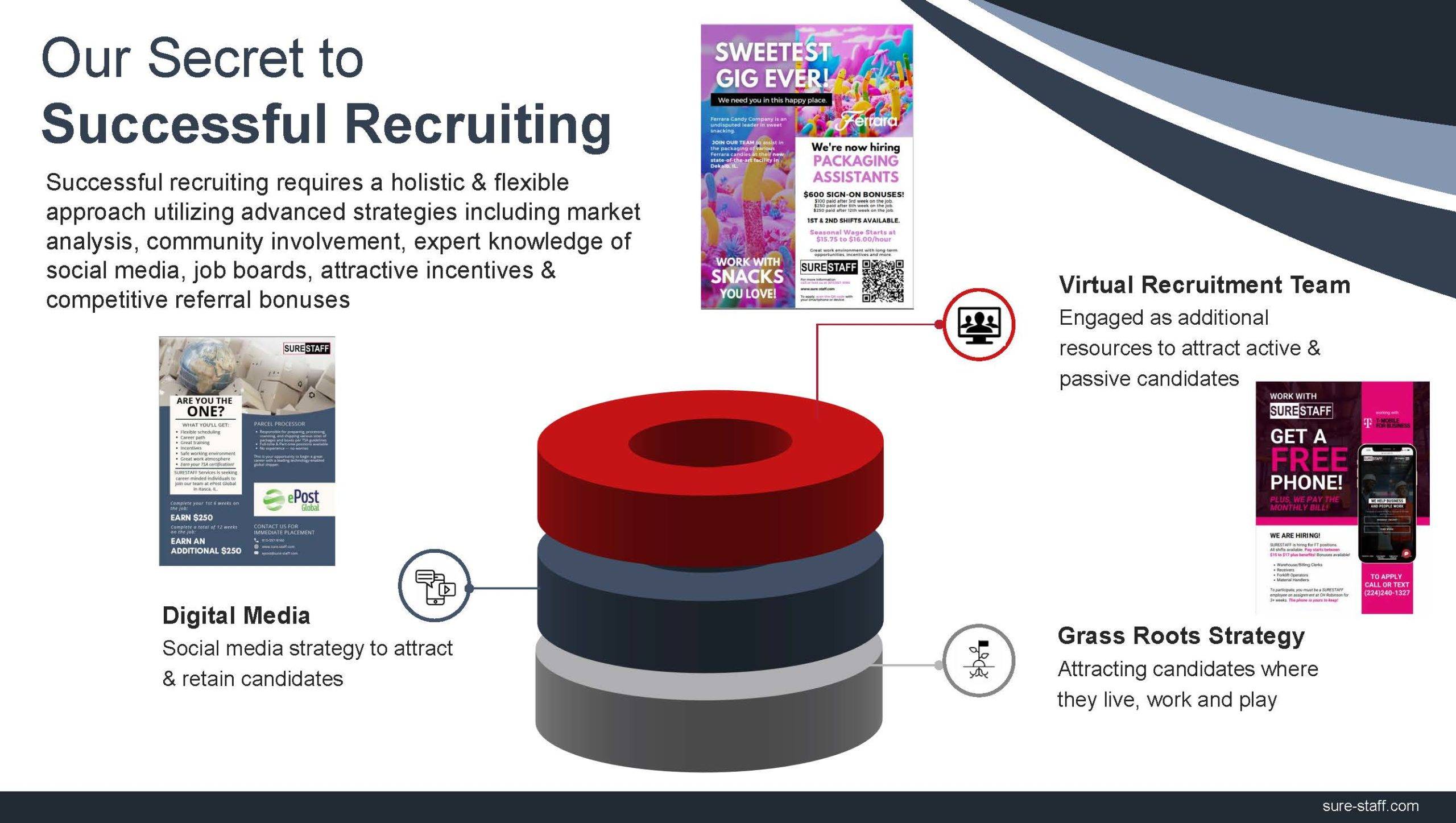
Recruiting is at the Core
Successful recruiting requires a holistic & flexible approach utilizing advanced strategies including market analysis, community involvement, expert knowledge of social media, job boards, attractive incentives, and competitive referral bonuses.
With any staffing model, recruiting is at the heart of the process. The ability to recruit the right people at the right time is a foundation to our partnered success. Surestaff utilizes a broad robust program that targets candidates where they are – whether physically or digitally. Our main recruiting components are: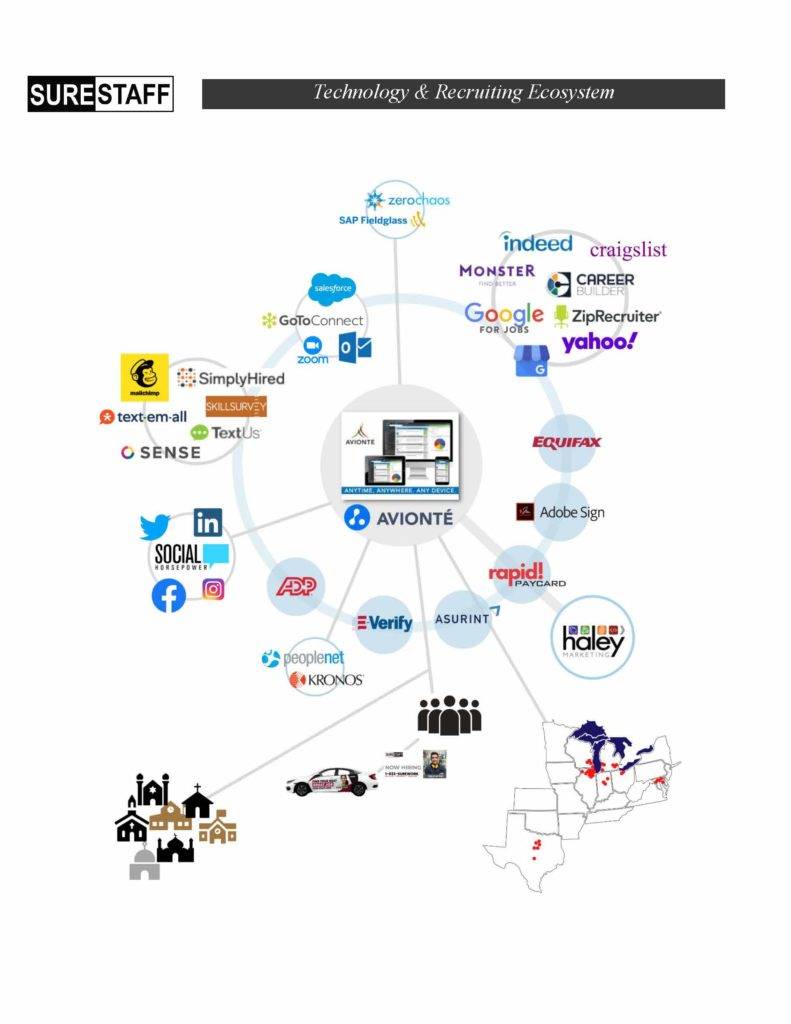
- Digital Strategies – Social media, job board platforms, web and digital, SEO/SEM strategies, employee and candidate and engagement, AI-driven outreach and response, live streaming advertising, and more.
- Corporate-based Centralized Recruiting Center (CRC) – From our headquarters in Chicago, Surestaff supplements branch and onsite recruiting with an effective team that manages and launches large-scale recruiting programs nationwide. This team advertises, sources, screens and evaluates candidates adding significant horsepower to the local recruiting effort.
- Grass Roots Strategy – Attracting candidates where they work and play continues to be an effective tactic. Yard signs, community outreach, flyers, job fairs, mobile recruiting centers, billboards, door hangers, as well as attractive incentives – free phones, referral bonuses, attendance and sign-on bonuses, recognition, free lunches and awards – all help with recruiting effectiveness.
Using an Onsite Staffing Program to Increase Productivity
For companies with 50 or more employees, using an onsite staffing program can significantly improve productivity and efficiency. You are able to “outsource” many of the organizational and HR-related duties, freeing up time and money to focus on internal management opportunities.
An onsite staffing program can be a great solution for many organizations. As we discussed earlier in this paper, many of the benefits range from reporting, KPIs and metrics, to efficient workforce management, employee coaching, and improved employee engagement.
At their core, some business models require a hands-on, time-consuming approach to staffing—especially where there is a high volume of contingent workers (such as contractors and freelancers) but the overall volume does not justify an outsourced solution. At some point, however, the volume provides an opportunity to consider an onsite solution.
The onsite solution allows companies to partner to one or several staffing companies and manage the contingent workforce at their location. This can lead to significant savings and increases in productivity—across the gamut of business.
Three ways to increase productivity
By having a well-designed staffing strategy and a formalized plan, you are already ahead of the game. The key is to be “proactive” versus “reactive” when it comes to recruitment. The following are three ways that an onsite staffing program can greatly help increase workforce productivity:
1. Reduce time to hire.
We all know that hiring timelines can vary greatly from company to company and position to position. But, when you incorporate a more strategic staffing plan, you’ll find more ideal candidates—and faster!
The first step is to partner with a staffing agency that can identify and send you qualified candidates from their pre-existing talent network.
When new employees are continuously recruited on-site, you’ll always have a pool of candidates ready to work. Thus, reducing the time to fill and increasing productivity on the job.
Pro tip: Don’t risk losing a top-notch applicant because you weren’t able to act quickly enough. In today’s competitive job market, top talent has been shown to be on the market for only 10 days.
Candidates’ expectations matter. If your hiring process is long and tedious, you risk someone forming a negative opinion of your company. When your hiring process is too drawn out, this can also impact company productivity and revenue when a position goes unfilled.
2. Streamline the onboarding process.
If your primary goal is to increase productivity, then workforce management (WFM) should also be at the top of your list of priorities.
One way to streamline the onboarding process is by implementing new optimized tools. When you digitize your onboarding process and automate day-to-day tasks, it will free up bandwidth—allowing managers to focus on other important high-level activities.
Training and development are also a key component of workforce management, as upskilling team members will improve capabilities and result in greater business performance. This can take a lot of time that business leaders may not have. An on-site staffing representative can handle these tasks, in addition to other activities such as performance reviews—also freeing up time.
3. Drive employee engagement and performance.
A third way to improve efficiency is through employee engagement. An on-site staffing manager can be utilized to motivate and encourage your workforce. This will ensure that the team is being as productive as possible, while also keeping morale high and absenteeism low. When you have an onsite team available, they can assist with check-ins, performance reviews, and resolve conflicts.
Having an onsite staffing team can also help ensure that safety is never compromised—by providing peace of mind for employees through engagement in safety education. Safety training programs have been proven to boost productivity and reduce the number of work-related accidents and illnesses.
Communication may also be improved because decisions can be made in real-time and in person. This will not only increase productivity (because things are being handled in a timely manner) but will also help foster an engaged and motivated culture. This will show your employees that you truly are making an investment in them.
Conclusion
Thank you for reading “The Ultimate Guide to Selecting a Staffing Partner.” We hope that you enjoyed the material and feel equipped with the tools you need to select the right staffing partner for your organization.
Here’s a recap of what we covered in this paper:
- We identified what an onsite or VOP staffing program is and outlined how an onsite staffing model provides a robust, unified, and holistic workforce strategy—with a personal and expert touch. We also discussed the many benefits of having a vendor-on-premise relationship.
- We covered the many ways that employing an onsite staffing program can ensure a better overall staffing strategy—including scaling your workforce and lowering labor and HR costs.
- We recommended that your staffing partner be a “strategic” one because a solid staffing plan requires that you first identify the gaps between your needs and your existing resources. Once you’ve put a strategic plan in place, then you should act on the tactical steps to reach your goals.
- We talked about the importance of choosing the right staffing partner and ensuring that you are maximizing their value. And we discussed why that relationship is an extremely important part of your recruitment strategy.
- We discussed the pros and cons of working with an offshore/offsite or onsite staffing model—to help you determine which solution makes the most sense for your company.
- Finally, we shared how using an onsite staffing program can greatly help increase productivity on the job site, as well as drive employee engagement and performance.
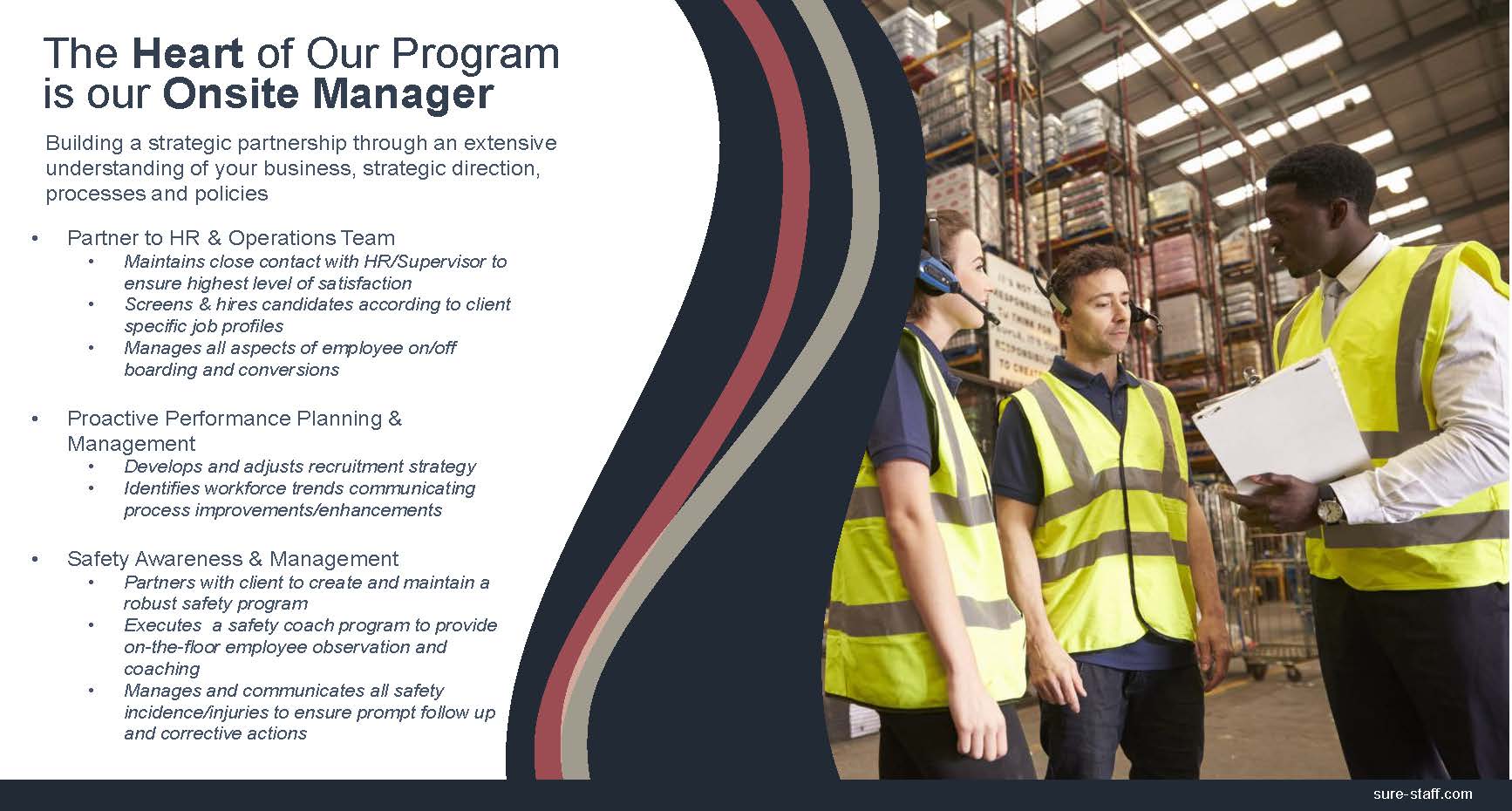
The SURESTAFF Onsite Solution
At SURESTAFF, we tailor our onsite solutions to fit your organization’s unique needs.
With our customer-centric approach, we offer the flexibility to deliver high-quality service to companies of all sizes. When we manage your workforce on-site, our team is dedicated to aligning staffing needs and performance with your organization’s business objectives—to provide maximum ROI.
Our onsite staffing services provide the benefits of a large temporary workforce, without the worry of hands-on management. We understand that high-volume staffing presents many challenges including rising costs, personnel shortages, and fluctuating production needs.
With more than 25 years of experience in distribution, logistics, e-commerce, and manufacturing our workforce consultants will design a solution that will control costs, maximize flexibility, and enhance the overall effectiveness and efficiencies of your workforce strategy without compromising on quality. Surestaff is one of the largest staffing agencies in the United States and provides a broad range of services – for all workforce solutions.
Additional Resources
For more information about Surestaff’s onsite staffing programs and workforce solutions, contact:
Sandy Picciola, CSP, Senior Vice President — Workforce Solutions Group
Phone: 815-412-4440
Email: spicciola@sure-staff.com

